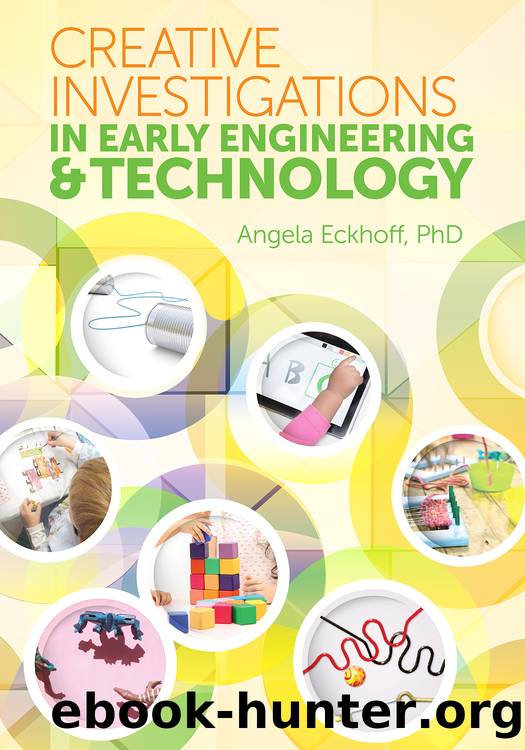Creative Investigations in Early Engineering and Technology by Angela Eckhoff

Author:Angela Eckhoff
Language: eng
Format: epub
Publisher: Gryphon House Inc.
Published: 2017-11-27T19:16:11+00:00
A variety of everyday objects can be used to construct a sound wall.
What Blocks the Light?
Topic:
Some materials allow light to pass through them (transparent), and others act as filters and only allow certain colors of light through (translucent), while others block light completely (opaque).
Objectives:
Children will explore the concepts of transparent, translucent, and opaque everyday items.
Children will group objects by the type of light each is allowing through.
Materials:
Small classroom materials that are transparent, translucent, and opaque (for example, wooden blocks, colored counting bears, translucent counters, transparent counters, and transparent light-table materials)
Light table or projector
Digital camera
Overview:
Children will work individually or in small groups depending on the size of your light table or projector.
Activity Steps:
1. Invite the children to play with the materials youâve collected, and ask questions about what they notice about their differencesââWhat happens to the light when I put this blue counting bear on the light table? Is that different than when I place this clear block on the table?â âWhat happens to the light when you place the pieces on top of each other?â
2. Be sure to give the children room to explore and interact with the objects in their own ways. During this time, you can also narrate what you are seeing about the relationship between light and objectsââWow, when you place the two clear pieces together, I can still see the light shining through.â
3. As the children are exploring, you can introduce the words and concepts of transparent, translucent, and opaque. Be sure to give the children room to explore and interact with the objects in their own ways.
4. As a final step in their explorations, invite the children to group the objects they believe are alike or different based upon their interaction with light.
5. Be sure to photograph their groupings to document their thinking and explorations.
Documentation:
You can take anecdotal notes on their explorations and play, and the photographs can serve as a final documentation.
Extension Lesson:
It is a good idea to invite children to repeat their play at the light table numerous times, as they will gain greater understanding during additional interactions. You can also invite the children to collect materials that they want to explore at the light table.
Download
This site does not store any files on its server. We only index and link to content provided by other sites. Please contact the content providers to delete copyright contents if any and email us, we'll remove relevant links or contents immediately.
Life in a Victorian School by Bob Mealing(149)
Math and Science Investigations by Sally Anderson(137)
Why Think? by Stanley Sara;(109)
Best Practices of Award-Winning Elementary School Principals by Harris Sandra K.;(92)
Introducing Research in Early Childhood by Bolshaw Polly;Josephidou Jo; & Jo Josephidou(90)
Wrestling with Writing by Nicholas D. Young & Bryan Thors Noonan & Kristen Bonanno-Sotiropoulos(86)
Loving Math by Unknown(83)
Transform Your K-5 Math Class by Amanda Thomas(80)
The Last Little Book About Big Words by James Roberts (Gentleman Jim)(69)
Brain-Compatible Activities for Mathematics, Grades 4-5 by Sousa David A.;(63)
Brain-Friendly Study Strategies, Grades 2-8 by Schwed Amy J.;Melichar-Utter Janice;(63)
What If Your ABCs Were Your 123s? by Leslie Minton(62)
Provoking Curiosity by Angela Eckhoff(58)
Help! for Teachers of Young Children by Kaltman Gwendolyn S.;(55)
Strategies to Integrate the Arts in Mathematics by Linda Dacey; Lisa Donovan(53)
Nonfiction Notebooks : Strategies for Informational Writing by Aimee Buckner(52)
Art in the Early Years by Eglinton Kristen Ali;(52)
Making Music in the Primary School by Beach Nick;Evans Julie;Spruce Gary;(51)
A Chance for Change by Crystal R. Sanders(45)
